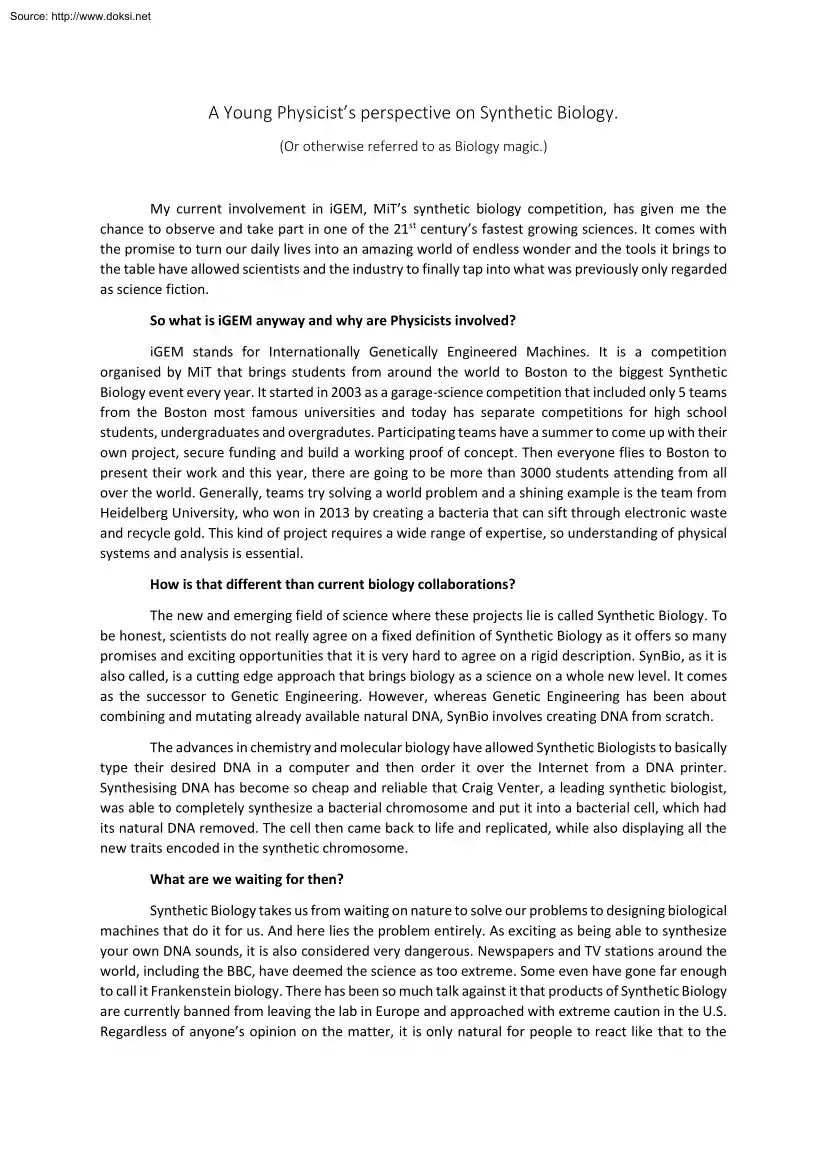Értékelések
Nincs még értékelés. Legyél Te az első!
Mit olvastak a többiek, ha ezzel végeztek?
Tartalmi kivonat
Source: http://www.doksinet A Young Physicist’s perspective on Synthetic Biology. (Or otherwise referred to as Biology magic.) My current involvement in iGEM, MiT’s synthetic biology competition, has given me the chance to observe and take part in one of the 21st century’s fastest growing sciences. It comes with the promise to turn our daily lives into an amazing world of endless wonder and the tools it brings to the table have allowed scientists and the industry to finally tap into what was previously only regarded as science fiction. So what is iGEM anyway and why are Physicists involved? iGEM stands for Internationally Genetically Engineered Machines. It is a competition organised by MiT that brings students from around the world to Boston to the biggest Synthetic Biology event every year. It started in 2003 as a garage-science competition that included only 5 teams from the Boston most famous universities and today has separate competitions for high school students,
undergraduates and overgradutes. Participating teams have a summer to come up with their own project, secure funding and build a working proof of concept. Then everyone flies to Boston to present their work and this year, there are going to be more than 3000 students attending from all over the world. Generally, teams try solving a world problem and a shining example is the team from Heidelberg University, who won in 2013 by creating a bacteria that can sift through electronic waste and recycle gold. This kind of project requires a wide range of expertise, so understanding of physical systems and analysis is essential. How is that different than current biology collaborations? The new and emerging field of science where these projects lie is called Synthetic Biology. To be honest, scientists do not really agree on a fixed definition of Synthetic Biology as it offers so many promises and exciting opportunities that it is very hard to agree on a rigid description. SynBio, as it is also
called, is a cutting edge approach that brings biology as a science on a whole new level. It comes as the successor to Genetic Engineering. However, whereas Genetic Engineering has been about combining and mutating already available natural DNA, SynBio involves creating DNA from scratch. The advances in chemistry and molecular biology have allowed Synthetic Biologists to basically type their desired DNA in a computer and then order it over the Internet from a DNA printer. Synthesising DNA has become so cheap and reliable that Craig Venter, a leading synthetic biologist, was able to completely synthesize a bacterial chromosome and put it into a bacterial cell, which had its natural DNA removed. The cell then came back to life and replicated, while also displaying all the new traits encoded in the synthetic chromosome. What are we waiting for then? Synthetic Biology takes us from waiting on nature to solve our problems to designing biological machines that do it for us. And here lies the
problem entirely As exciting as being able to synthesize your own DNA sounds, it is also considered very dangerous. Newspapers and TV stations around the world, including the BBC, have deemed the science as too extreme. Some even have gone far enough to call it Frankenstein biology. There has been so much talk against it that products of Synthetic Biology are currently banned from leaving the lab in Europe and approached with extreme caution in the U.S Regardless of anyone’s opinion on the matter, it is only natural for people to react like that to the Source: http://www.doksinet science whose sole purpose is creating more artificial stuff. In a society who is obsessed with making sure all its food is free of all non-natural ingredients, SynBio looks all too familiar to some. Everyone seems to approach SynBio from the same “bad” angle – genetically modified food. But GMOs don’t really need be connected to food. iGEM and Synthetic Biology almost never mention food. The
focus of the science is more into biological machines than anything else Scientists want to cure disease, create fuel and energy, improve manufacturing processes, detect and filter toxic waste from water and a million other things that are already done completely artificially. For example, Jay Keasling and his team from UC, Berkley are using modified yeast to produce cheaply the anti-Malarial drug Artemisenin in large enough quantities to treat 200 million sufferers each year. Also, there is a possibility that scientists will be able to engineer algae to consume greenhouse CO2 from the atmosphere and produce less polluting biofuels. Or something even more ground-breaking, like doing away with construction, urban planning, forestry and gardening by creating a seed that can grow into a house. The point is that we cannot allow ourselves to be so harshly judgemental about a science that brings us a lot of new options to solve our problems. Especially in this time, when anti-biotics are no
longer able to cure our diseases, when air pollution is destroying our climate and the energy crisis looks more tangible than ever. Now is the time for us to look into a new approach to solve our problems, not start crossing out items from the list based on prejudice. SynBio can only do so much and show us the possibilities. It is up to us to be open enough to accept them for what they are and realise how much we need a miracle like it right now
undergraduates and overgradutes. Participating teams have a summer to come up with their own project, secure funding and build a working proof of concept. Then everyone flies to Boston to present their work and this year, there are going to be more than 3000 students attending from all over the world. Generally, teams try solving a world problem and a shining example is the team from Heidelberg University, who won in 2013 by creating a bacteria that can sift through electronic waste and recycle gold. This kind of project requires a wide range of expertise, so understanding of physical systems and analysis is essential. How is that different than current biology collaborations? The new and emerging field of science where these projects lie is called Synthetic Biology. To be honest, scientists do not really agree on a fixed definition of Synthetic Biology as it offers so many promises and exciting opportunities that it is very hard to agree on a rigid description. SynBio, as it is also
called, is a cutting edge approach that brings biology as a science on a whole new level. It comes as the successor to Genetic Engineering. However, whereas Genetic Engineering has been about combining and mutating already available natural DNA, SynBio involves creating DNA from scratch. The advances in chemistry and molecular biology have allowed Synthetic Biologists to basically type their desired DNA in a computer and then order it over the Internet from a DNA printer. Synthesising DNA has become so cheap and reliable that Craig Venter, a leading synthetic biologist, was able to completely synthesize a bacterial chromosome and put it into a bacterial cell, which had its natural DNA removed. The cell then came back to life and replicated, while also displaying all the new traits encoded in the synthetic chromosome. What are we waiting for then? Synthetic Biology takes us from waiting on nature to solve our problems to designing biological machines that do it for us. And here lies the
problem entirely As exciting as being able to synthesize your own DNA sounds, it is also considered very dangerous. Newspapers and TV stations around the world, including the BBC, have deemed the science as too extreme. Some even have gone far enough to call it Frankenstein biology. There has been so much talk against it that products of Synthetic Biology are currently banned from leaving the lab in Europe and approached with extreme caution in the U.S Regardless of anyone’s opinion on the matter, it is only natural for people to react like that to the Source: http://www.doksinet science whose sole purpose is creating more artificial stuff. In a society who is obsessed with making sure all its food is free of all non-natural ingredients, SynBio looks all too familiar to some. Everyone seems to approach SynBio from the same “bad” angle – genetically modified food. But GMOs don’t really need be connected to food. iGEM and Synthetic Biology almost never mention food. The
focus of the science is more into biological machines than anything else Scientists want to cure disease, create fuel and energy, improve manufacturing processes, detect and filter toxic waste from water and a million other things that are already done completely artificially. For example, Jay Keasling and his team from UC, Berkley are using modified yeast to produce cheaply the anti-Malarial drug Artemisenin in large enough quantities to treat 200 million sufferers each year. Also, there is a possibility that scientists will be able to engineer algae to consume greenhouse CO2 from the atmosphere and produce less polluting biofuels. Or something even more ground-breaking, like doing away with construction, urban planning, forestry and gardening by creating a seed that can grow into a house. The point is that we cannot allow ourselves to be so harshly judgemental about a science that brings us a lot of new options to solve our problems. Especially in this time, when anti-biotics are no
longer able to cure our diseases, when air pollution is destroying our climate and the energy crisis looks more tangible than ever. Now is the time for us to look into a new approach to solve our problems, not start crossing out items from the list based on prejudice. SynBio can only do so much and show us the possibilities. It is up to us to be open enough to accept them for what they are and realise how much we need a miracle like it right now





 Jellemzően a vállalkozás beindítása előtt elkészített tanulmány, de készülhet már meglévő vállalkozás esetében is. Az üzleti tervezés egy olyan tervezési módszer, amely keretet a cég céljainak eléréséhez. Írásunk módszertani útmutatóként szolgál azoknak, akik érdeklődnek az üzleti tervezés iránt.
Jellemzően a vállalkozás beindítása előtt elkészített tanulmány, de készülhet már meglévő vállalkozás esetében is. Az üzleti tervezés egy olyan tervezési módszer, amely keretet a cég céljainak eléréséhez. Írásunk módszertani útmutatóként szolgál azoknak, akik érdeklődnek az üzleti tervezés iránt.